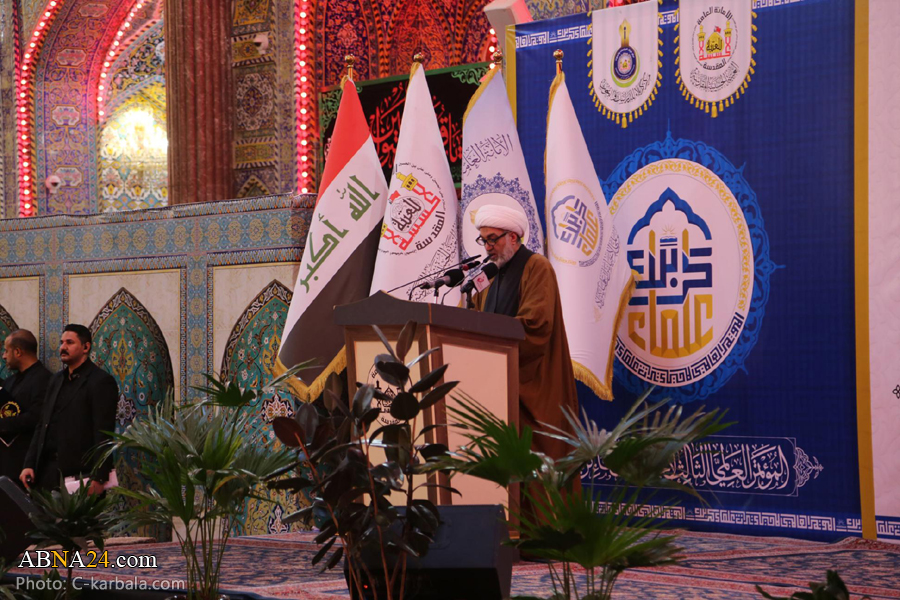AhlulBayt News Agency (ABNA): Hojat al-Islam Dr. Sayed Abd al-Hadi Mohammad Taghi Al-Hakim stated, “The goal of Marjaiat and Mirza Shirazi was, first of all, the complete liberation of Iraq from the British occupation, and then the establishment of an independent government and political system.”
The opening ceremony of the Conference to Commemorate Grand Ayatollah Mirza Mohammad Taghi Shirazi was held on Saturday, December 10, 2022.
The ceremony was held in the Holy Shrine of Imam Hussain (a.s.) in Karbala with the large presence of ulama, clerics, national and military figures, chiefs and sheikhs of tribes, researchers and professors from the universities of Iraq, Iran and a number of other countries of the world.
After the recitation of the Holy Quran, six speeches and the reading of an ode, the ninth and last program of the opening ceremony of the Conference to Commemorate Grand Ayatollah Mirza Mohammad Taghi Shirazi was held, which was the presentation of a paper of the Hojat al-Islam Dr. Sayed Mohammad Taghi Al-Hakim.
Hojat al-Islam Sheikh Farhan Al-Saeedi presented this article and at the beginning of his speech stated, “Dr. Sayed Abd al-Hadi Mohammad Taghi Al-Hakim could not participate in the ceremony due to illness and entrusted the presentation of his article to me.”
The main question of Dr. Al-Hakim’s article was, “Was the goal of Mirza Mohammad Taghi Shirazi in the 1920 Revolution just the independence of Iraq from British colonialism or did he have a goal beyond that, and his goal was to establish a new political system for Iraq?”
The hypothesis of the article was, “The goal of Marjaiat and Mirza Shirazi was, first of all, the complete liberation of Iraq from the British occupation, and then the establishment of an independent government and political system.”
Then, explaining his arguments, the author of the article stated, “Mirza Shirazi issued a fatwa of Jihad against the British and led the Revolution. However, after his demise, the movement did not stop, but other Grand Marjas, such as Sheikh al-Sharia Esfahani, issued fatwas that led to the continuation of the Iraqi people’s independence movement.”
“The rest of the great ulama of the time, such as Ayatollah Akhund Khorasani, Ayatollah Mirza Naini, Ayatollah Sayed Abu al-Hasan Isfahani, Ayatollah Sayed Abu al-Qasem Kashani, and Ayatollah Sayed Ismail Shirazi, first support Mirza Shirazi, and then supported Shaykh al-Sharia. After the independence of Iraq, they continued the movement of constitutionalism,” the researcher continued.
Sayed Abd al-Hadi Al-Hakim, quoting one of the English advisers of that time, said, “The ultimate goal of this Revolution in Iraq was the establishment of a religious and Islamic state based on the Shiite Sharia.”
“Could Marjaiat form such state? The answer is yes. After the liberation of Karbala and Najaf from the British occupation, the Marjaiat created a constituent board and established Islamic rule in these two cities as far as it could,” the author added.
“Sheikh Abd al-Karim Jazayeri, Mirza Ahmad Khorasani (the son of Akhund Khorasani), Sheikh Jafar Abu al-Tamman al-Baghdadi, and a number of other Iraqi elders and ulama were present in this board,” he continued.
Al-Hakim then mentioned the formation of two academic and executive (national) councils for the administration of the cities of Karbala and Najaf with the presence of some ulama, such as Sayed Hebatuddin Shahrestani, Sayed Abu al-Qasem Kashani, Mirza Ahmad Khorasani, Sayed Hussain Qazvini and Mirza Abd al-Hussain Shirazi (son of Mirza Shirazi).
According to Mr. Al-Hakim’s research, there are two reports about the period of rule of these boards in Najaf. The first refers to three months and twenty-three days of rule, while the other refers to one year and seven months.
“After the victory in the 1920 revolution, the next step of the Marjaiat and the revolutionaries was to establish a legislative assembly through holding elections. Elections were held on August 25, 1925, and two people from each neighborhood of Najaf were elected to attend the legislative assembly of the city. on August 26, right after the elections, the first session of this parliament was held with the presence of figures such as Sayed Abbas Kelid-dar,” Al-Hakim stated.
Further in his article, the Iraqi researcher explained the procedure of the movement of the revolutionaries of the 1920 movement to establish an independent and modern Iraqi government.
After the end of his presentation, the “The Proceedings of the Conference Commemorating Grand Ayatollah Mirza Mohammad Taghi Shirazi” was unveiled, and the opening ceremony ended an hour before Maghrib Azan of Karbala.
* The Series of International Conferences for the Revival of the Heritage of the Ulama of Karbala
It should be mentioned that the Commemoration Conference for Ayatollah Mirza Mohammad Taghi Shirazi is the third of the Series of International Conferences for the Revival of the Heritage of the Ulama of Karbala which dedicated to commemorating and revival the works of the ulama of Karbala.
The organizer of these series of conferences is the Karbala Center for Studies and Research, the Scientific Section of the Holy Shrine of Imam Hussain (a.s.). Previously, Karbala Center held the first and second conferences to commemorate Allameh Vahid Behbahani, and great faqih and hadith narrator Ibn Fahd Hilli.
The title of the 3rd conference of these Series of International Conferences, was “Ayatollah Mirza Mohammad Taghi Shirazi - Thoughts and Leadership”, which was held by Research Center of the Holy Shrine of Imam Hussain (a.s.) in cooperation with the Shiraz University as partner organizer.
The opening ceremony of this conference was held in the Holy Shrine of Imam Hussain (a.s.) on Saturday, December 10, 2022, and then, after Maghrib and Isha prayers, researchers from different countries presented their articles in the evening scientific session which was held in Sayed al-Osia Complex.
On Sunday morning, December 11, 2022, the scientific session continued their activities, and the closing ceremony was held on Sunday evening.
It is also worth mentioning that the ABNA News Agency by dispatching reporters covered the detailed news and pictures of this conference exclusively. /345/

